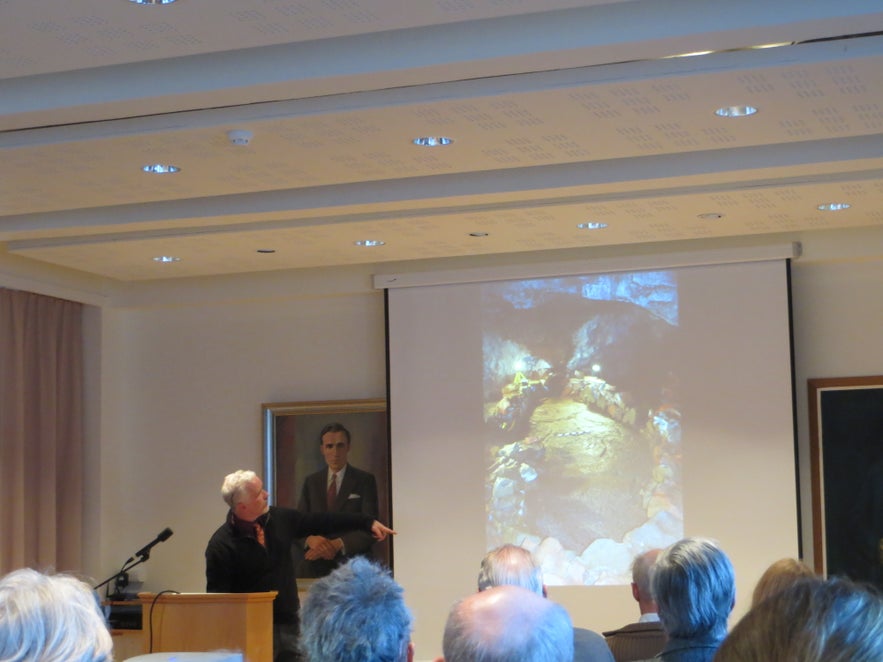
Surtshellir Cave | Den of Thieves or Temple of Doom ?

(With the kind permission of Kevin B. Smith from Brown University - lecturing Reykholt on 22nd of February 2014)
ln the 13th century text Landnámabók (Pálsson and Edwards 1972), the 14th century Harðar saga ok Hólmverja (Jónsson 1953), and the fictive 19th century Hellismanna saga (Árnason 1889) Surtshellir is identified as the base of an outlaw band that fortified the cave in the late 10th century preying on the surrounding countryside until routed by a coalition of local chieftains.
The presence of bone piles and a stone-walled structure have been anecdotally recorded since the 17th century and a single radiocarbon date was run on a Bos bone fragment in 1969 by the lcelandic author Halldór Laxness. These fragmentary records have been used in the past to suggest archaeological suppott for the historical narratives. However, the calibrated age of Laxness'date spans the entire Settlement and Commonwealth periods (AD 870-1264) and could reference activities undeftaken at any point in the early Middle Ages.
Surtshellir is one of thirty-three lcelandic caves with evidence of human occupation or activities from the time of lceland's initial Norse settlement (ca. AD 874) to the recent past. Seven are known within the Hallmundarhraun; two of these had received some archaeological attention prior to these investigations (Gestsson 1960; Ólafsson 2000).
Fieldwork in Surtshellir therefore provided opportunities to determine whether the cave's archaeological deposits could be dated to the Settlement period, to inventory and characterize the archaeological features and deposits within it, possibly togain new insight into outlaws'material culture and their impacts on the regional economy, and to contribute data from the North Atlantic to the study of caves in archeological record.
Surtshellir is an unusual Viking Age lcelandic site. Place names within the cave, coupled with the documented archaeological features and deposits, suggest a relatively extensive and complex suite of archaeological remains including fortifications, a subterranean house, middens, and extremely thin and fragile occupation deposits. The main habitation zone is located c. 200 meters from the cave's entrance, well beyond the penetration of any natural light. Separated from the entrance passages by a massive fortification wall in a hidden side passage, it was obviously not meant to be an accessible place. The thickness of the midden layer shows that it accumulated over some time. AMS dates confirm a late 11.th or 1O.th century age for the bonebearing deposits, while the form of the adjacent structure bears many similarities to known Viking Age halls.
please notice!! Because of risk of stones falling down from the roof, Surtshellir should not be visited without a local guide and always with proper safety equipment.
For more information visit Snorrastofa or see West Iceland.
기타 흥미로운 블로그
요쿨살론부터 비크까지, 꽃보다 청춘 5화
드디어 하늘씨과 쓰리스톤즈가 합류했는데요! 설원을 달리는 모습에 저도 아이슬란드가 엄청 그리워졌답니다. 빙하와 빛나는 요쿨살론 첫번째로 향한 요쿨살론(Jokulsarlon)은 아이슬란드의 대표적인 명소 중 하나랍니다. 영어로 Glacier lagoon 이라고도 하는데요. 방송에 나온 것처럼 눈 앞에 보이는 빙하는 빙하수가 흘러서 녹았다 얼었다를더 보기스코가포스 폭포부터 오로라까지, 꽃보다청춘 4화를 따라서
여행 5일째, 포스톤즈가 처음으로 향한 곳은 아이슬란드 남부에 있는 스코가포스 폭포(skogasfoss)입니다. 아이슬란드 남부의 대표적인 폭포 중 하나에요. 방송에서는 들르지 않았지만 스코가포스 거의 바로 옆에 위치한 셀리야란드스포스(seljalandsfoss) 폭포와 함께 같이 들르곤 한답니다. 스코가포스 폭포는 폭포의 물줄기 끝까지 올라갈 수 있단더 보기꽃청춘을 따라서
요즘 인기리에 방영되고 있는 꽃보다 청춘 아이슬란드편! 저도 매주 빼놓지 않고 시청하고 있습니다. 많은 분들께서 포스톤즈의 발랄한 매력과 아이슬란드의 놀라운 경치에 빠져드셨을 것 같습니다! 이번에는 꽃보다 청춘을 따라서 아이슬란드를 한번 가보도록 해요! 사실 아이슬란드가 한국에서 그렇게 가기 쉬운 나라는 아닙니다. 거리도 멀고 항공권도 비싸고! 우더 보기

아이슬란드 최대의 여행 마켓플레이스를 전화에 다운로드하여 전체 여행을 한 곳에서 관리하세요
전화 카메라로 이 QR 코드를 스캔하고 표시되는 링크를 누르면 아이슬란드 최대의 여행 마켓플레이스를 주머니에 넣을 수 있답니다. 다운로드 링크가 포함된 SMS 또는 이메일을 받으려면 전화번호 또는 이메일 주소를 추가하세요.

















